By Helene Ravlich
Over the past eighteen months, the term “face mask” has come to mean a lot more than just a little self-care on a Sunday evening. It’s become a reality when we leave the house, and a way to save lives in my countries hard hit by the global pandemic. Wearing a mask out in public doesn’t pose any real problems for most people, aside from mild annoyance and getting a little overheated in the summer months. Oh and not getting to show off that beautiful new lip colour, which is a whole other story! But for those with sensitised or problematic skin, masks have bought about an infuriating condition along with their powers of protection: “Maskne,” or acne caused by wearing a mask.

Maskne isn’t necessarily a new phenomenon say medical professionals, who have worn masks for years. And thankfully they have done the hard work for all of us, working out what causes it, how to deal with it and how to (hopefully) prevent it in the first place.
With all of us faithfully donning masks under yet another difficult – but necessary – lockdown, we thought we’d break down why you’re breaking out, and what you can do about it.
Firstly, what exactly is “maskne”?
Maskne is medically called acne mechanics, which is acne that is caused by heat, friction, and occlusion. By wearing a mask, a fertile, warm and moist environment is created from breathing, talking, laughing, etc., which then leads to an overgrowth of a natural bacteria called P.acnes. P.acnes, when it overgrows, can lead to acne breakouts. On top of all that, the occlusion and friction from a mask combined with our skin’s oil and sweat can cause irritation, which can lead to irritant-contact dermatitis or dry, itchy, and even raw skin. Additionally, stress–both physically on the skin barrier, and internal stress during these more challenging times—can contribute to the phenomenon we now know as maskne.
So what can I do?
Preventing maskne starts with your choice of face mask. Opting for a mask made from tightly woven, soft cotton fabric and ensuring it’s regularly washed with mild detergent or unscented soap and thoroughly rinsed is key, so we recommend having a few on the go so you’re never caught short after washing day.
Treating maskne also means avoiding thick, occlusive skincare creams and swapping them out for more lightweight water-based products. A lightweight moisturiser like Emma Lewisham’s Illuminating Brighten Your Day Crème can also act as an additional protective barrier and prevent chafing.

Illuminating Brighten Your Day Crème RRP $110.00
Ideally, you should also be using a mild and gentle exfoliator like Jeunora’s new SupearlaNova Hydrating Face Polish beforehand to support the absorption of your moisturiser.

Hydrating Face Polish RRP $63.00
If your problems persist, using products that are formulated to help tackle blemishes is a great idea because the moist, hot environment and constant rubbing of the mask can more easily lead to acne mechanica. But the key here is to not go from zero to ten all at once. Incorporate gentle, blemish-banishing formulas and be sure not to dry out your skin or agitate it, which can actually lead to more vulnerable skin and more breakouts. Dermalogica’s Clear Start range and new Daily Glycolic Cleanser are worth exploring, especially the latter as it helps maintain a healthy barrier.

Daily Glycolic Cleanser RRP $67.00
Can I still wear makeup?
This is a tough one, we love a good glow up at any time of year! It’s not such an issue when we’re all confined to the living room, but once levels start to lift it’s worth a rethink of your current daily face. If you can, skip out on using a heavily pigmented foundation or any heavy makeup when wearing a mask, and check out the growing number of vloggers who are making mask-friendly makeup tutorial videos.
Heavily contoured looks and a statement lip are out, and bold eyes are in, so make friends with a slick, long lasting eye liner like Shiseido’s MicroLiner Ink, and multi-use palettes like the Too Faced Born This Way The Natural Nudes Complexion Inspired Eye Shadow Palette from MECCA. This combo will definitely be a great investment, allowing multiple eye looks that will carry you through day and night.

Shiseido Microliner Ink RRP $51.00

Born This Way The Natural Nudes Complexion Inspired Eye Shadow Palette RRP $77.00
This trend is expected to continue for the foreseeable future too. As long as we are still living in the pandemic, face masks will become part of our everyday and our makeup looks will thankfully evolve along with that.
Header Image retrieved from Unsplash
Second Image retrieved from Unsplash

